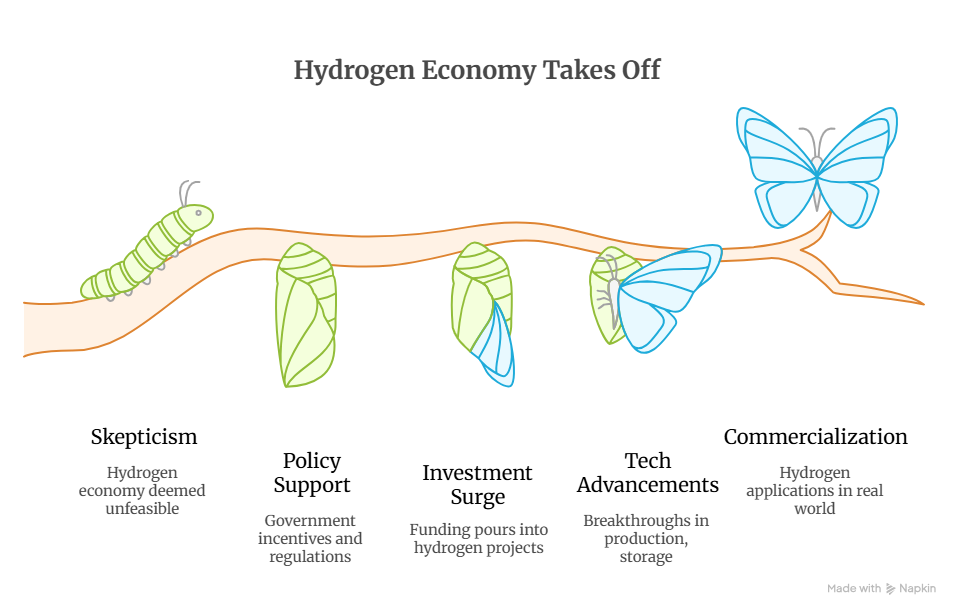They Said Hydrogen Economy Wouldn't Work—2025 Proved Them Wrong
“For years, the hydrogen economy has failed to materialize in any meaningful way for the average consumer,” Forbes observed earlier this year.
That line summed up the doubts surrounding hydrogen’s role in the energy transition. Yet in 2025, the picture looks very different. Momentum is building across industries, and the idea of a hydrogen-powered future is beginning to take shape. Let’s dig into the details of hydrogen economy further!

Policy Paves the Way:
The first and perhaps most decisive factor behind this progress is policy support. Governments worldwide are introducing incentives, regulations, and funding initiatives that make hydrogen more competitive:
Global Policy Momentum
- The European Union has been a pioneer in Hydrogen policy, introducing the REPowerEU Strategy in 2022. It aims to produce 10 million tonnes by 2030, and by 2050, renewable hydrogen is set to cover around 10% of the EU’s energy needs[1].
Its policy framework was proposed by a commission in July 2021, as part of the popular ‘Fit for 55 package’ that includes:
-
- Binding targets for the uptake of renewable or green hydrogen in industry and transport sectors by 2030.
There’s also the Hydrogen and decarbonised gas market package that came into force in 2024 to:
-
- Support the creation of top-notch infrastructure for hydrogen, as well as an efficient hydrogen market
- In the US, the hydrogen economy policies are regulated by the Department of Energy. There’s a US National Hydrogen Strategy and Roadmap that guides the production, storage, and transportation of hydrogen, examining scenarios for 2030, 2040, and 2050. The Infrastructure Investment and Jobs Act offers various tax credits for hydrogen production as well as fuel cell vehicles.

The Investment Deluge:
Investments are coming into hydrogen projects like never before, and here are some points that highlight it:
Capital Inflow Acceleration
Statistics show that total investment in hydrogen projects has increased from $390 billion in May 2022 to around $680 billion in May 2024. On the other hand, in Europe, $193 billion worth of investments in hydrogen projects have already been made, and more is yet to come[2].
De-risking & Scalability
The hydrogen economy often seems risky to people, often because it’s expensive and depends upon an unproven market. Nonetheless, governments are now offering low-interest loans and grants to reduce the financial, operational, and safety uncertainties associated with this concept.
Technological Leaps: Production, Storage, and Distribution Advancements
Advances in production, storage, and distribution are turning hydrogen from a costly vision into a practical energy solution.:
- Efficient and Affordable Production: Electrolyzer technology remains central, with proton exchange membrane (PEM) and solid oxide (SOEC) designs improving efficiency and lowering costs. Coupled directly with wind and solar farms, these systems enable large-scale green hydrogen production. Researchers are also exploring next-generation methods such as photocatalytic water splitting and biomass-based hydrogen, which could further expand sustainable pathways in the near future.
- Infrastructure Innovation: For the storage and release of hydrogen, there are infrastructure innovations, such as liquid organic hydrogen carriers (LOHCs). These liquids store hydrogen via catalytic hydrogenation and dehydrogenation cycles. Materials like metal hydrides also have potential for optimizing hydrogen release kinetics.
- Advanced Fuel Cells: There are continuous advancements to improve the efficiency and reliability of hydrogen fuel cells. For instance, engineers are focusing on cheaper but durable materials like MEA and also exploring 3D technology to develop fuel cells at a large scale.
Hydrogen Hits the Road (and Beyond): Real-World Commercialization
Technological breakthroughs are now translating into real-world applications, bringing hydrogen out of the lab and onto roads, rails, and beyond:
- Mobility Takes the Lead: Hydrogen can be used in the mobility sector, including long-haul trucks and public transport such as buses, due to its long range and fast refueling. Forklifts and other warehouse logistics vehicles will also utilize hydrogen as the primary fuel, serving as a zero-emission alternative.
- Expanding Horizons: In addition, hydrogen is also making its way to other fields, such as:
- Aerospace: Propellant for rockets and spacecraft.
- Maritime: Used in fuel cells for ship propulsion while minimizing emissions.
- Manufacturing: Acts as a reducing agent in the iron ore reduction process and in metallurgy for metal treatment.

Conclusion
The hydrogen economy is no longer a buzzword; it’s going to be the reality of the future world. If you are eager to learn about a hydrogen based economy and how you can benefit from it, join the Mobility Tech Asia conferences today!
References
[1] Available at: https://energy.ec.europa.eu/topics/eus-energy-system/hydrogen_en (Accessed: 10th, September)
[2] What is hydrogen energy? Available at: https://www.mckinsey.com/featured-insights/mckinsey-explainers/what-is-hydrogen-energy (Accessed: 10th, September)


